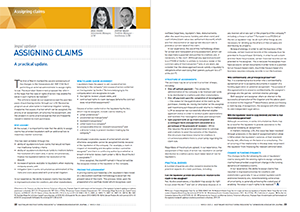Assigning claims – A practical update

Assigning claims - A practical update
Download PDF ArticleSiba Diqer and Justin Ward write for the Australian Restructuring, Insolvency & Turnaround Association Journal (Volume 32 #01 2020) on pricing, structure and the practicalities involved in the purchase of causes of actions belonging to a company and those conferred on the liquidator by the Corporations Act 2001 (Cth).
The first of March marked the second anniversary of the changes to the Corporations Act 2001 (Cth) (Act) permitting an external administrator to assign rights to sue.
The Australian Government proposed the reform in the hope that the ‘sale of rights of action may enable the value in such rights to be realised’[1].
This article is based on our experience over the past two years of purchasing claims through our LCM Recoveries program as an alternative to traditional litigation funding.
It explores the causes of action which can be assigned, the pricing of an assignment, structuring the assignment, and the answers to some practical queries that are frequently raised in relation to claim purchases.
Why assign?
At the outset, it is important to note that the ability to assign claims has provided liquidators with an additional tool to maximise creditor outcomes.
This has been achieved through the:
- ability of liquidators to fund claims that would not have met traditional funding criteria
- ability of liquidators to distribute funds to creditors before the resolution of a claim and, in some circumstances, finalise the liquidation before the resolution of the dispute
- increase of options available to liquidators when realising company assets, and
- mitigation (and in some circumstances elimination) of the risks and costs associated with protracted litigation. In our experience, the ability to assign claims has resulted in improved outcomes for creditors and other stakeholders.
What claims can be assigned?
Liquidators have the power to sell causes of action belonging to the company[2] and causes of action conferred on the liquidator by the Act.[3] Actions belonging to the company which are assignable include:
- the right to recover unpaid debts, and
- contractual rights to claim damages (where the contract does not prohibit assignment).[4]
Causes of action conferred on the liquidator by the Act, which may be assigned, include claims relating to:
- unfair preferences[5]
- uncommercial transactions[6]
- insolvent transactions[7]
- unfair loans to a company[8]
- unreasonable director-related transactions[9], and
- a director’s duty to prevent insolvent trading by the company[10].
A company’s statutory causes of action which are not otherwise assignable cannot be assigned merely because of the liquidation of the company. For example, a claim in respect of misleading and deceptive conduct cannot be assigned[11], and there is conflicting authority on whether a breach of director duties claim under s 180 to 184 of the Act is assignable[12].
Once assigned, the plaintiff named in the action will be the assignee instead of the liquidator or the company.
Pricing the assignment
In pricing claims purchased by LCM, liquidators have relied on a discounted cashflow methodology to ascertain the present value of the claim. This process relies upon the preparation of a cashflow model which recognises cash outflows (legal fees, liquidator’s fees, disbursements, after-the-event insurance, funding and other costs) and cash inflows (claim value less settlement discount), which are then discounted at an appropriate discount rate to provide a current value of the claim.
In our experience, the use of this methodology allows for a clear and transparent pricing assessment, which can be objectively supported and justified to creditors and, if necessary, to the court. (Although any approval pursuant to s 477(2B) of the Act is unlikely to include a review of the commerciality of the transaction[13] and, in any event, we consider that the above approach would satisfy a liquidator’s obligations when exercising their powers pursuant to s 477 of the Act[14]).
Structure of assignments
The purchase may be structured in a number of ways, including:
- One-off upfront payment – This allows the administration of the company to be finalised and funds to be distributed to creditors and other stakeholders.
- One-off payment upon the completion of investigations – This allows for the quantification of the claim by the purchaser, thereby de-risking the matter for the assignee and maximising purchase price and returns to creditors. LCM as assignee has successfully obtained eligible applicant status in order to conduct public examinations and facilitate this investigation phase post assignment.
- Split payment with an up-front component and a contingent back-end payment calculated as a percentage of the proceeds of recovery – While this requires the external administration to continue and creditors to await the outcome of the litigation, this structure maximises returns for creditors in circumstances where there is uncertainty regarding the claim size.
Regardless of the structure agreed, in our experience, the assignment of the cause of action has resulted in an earlier distribution to creditors and a much lower level of risk for liquidators.
Practical queries
A number of queries are often raised in relation to the practical aspects of a claim purchase, including:
Can the liquidator provide documents in relation to the claim to the assignee?
Yes. As discussed above, a liquidator may assign its right to sue under the Act[15] and ‘sell or otherwise dispose of, in any manner, all or any part of the property of the company’[16] including a chose in action[17]. Pursuant to s 477(2)(m) of the Act, a liquidator may ‘do all such other things as are necessary for winding up the affairs of the company and distributing its property’.
By way of analogy, in order to sell the business of the company, certain financial records of the company must be provided to the purchaser. Similarly, in order to sell a claim and distribute the proceeds, certain financial records can be provided to the assignee. This is because the assignee must have access to certain documents in order to be in a position to run the purchased claim, much like the purchaser of a business requires company records to run the business.
Will confidentiality and privilege be preserved?
Yes. It is standard practice to enter into a confidentiality agreement prior to accepting documents in support of a funding application or potential assignment. The purpose of this agreement is to preserve confidentiality, the assignor’s privilege and the parties’ common interest privilege.
Both assignor and assignee ‘share an interest in the successful prosecution of the litigation and the advice given in relation to the litigation’[18]. Nevertheless, when purchasing a claim by way of assignment, the assignee will often obtain its own independent legal advice.
Will the liquidator need to stay involved and how is that relationship governed?
Although uncommon, in some circumstances there may be a need for the liquidator to provide assistance to the assignee following an assignment.
In matters involving LCM, this issue has been resolved through provisions in the deed of assignment which allow LCM to obtain the liquidator’s services at their standard hourly rate, effectively on the basis of a consultancy. The structuring of the relationship in this way does not prevent the liquidator from finalising the relevant administration.
Change in funding dynamics
The changes to the Act allowing the sale of liquidators’ claims (along with the existing rights to assign company claims) have provided a significant change in the funding dynamics of insolvency claims.
In our experience, the ability to assign claims has resulted in improved outcomes for creditors and stakeholders generally. It has provided liquidators with additional flexibility and, notwithstanding some areas of uncertainty, is generally achieving the stated goal of enabling ‘the value in such rights to be realised’[19].
Footnotes:
1 Secretary to the Treasurer and Attorney-General, Parliament of Australia, Proposals Paper: A modernisation and harmonisation of the regulatory framework applying to insolvency practitioners in Australia, (2011) 39.
2 Corporations Act 2001 (Cth) s 477(2)(c).
3 Insolvency Practice Schedule (Corporations) s 100-5.
4 Pentridge Village Pty Ltd (in liq) v Capital Finance Australia Ltd [2018] VSC 633; CGS Owners of Strata Plan No 5290 v CGS & Co Pty Ltd (2011) 81 NSWLR 285.
5 s 588FA.
6 s 588FB.
7 s 588FC.
8 s 588FD.
9 s 588FDA.
10 s 588G.
11 Pentridge Village Pty Ltd (in liq) v Capital Finance Australia Ltd [2018] VSC 633; Aquatic Air Pty Ltd v Siewert [2015] NSWSC 928.
12 Re Colorado Products Pty Ltd (in prov liq) (2014) 101 ACSR 233 compared with Re Novaline Pty Ltd (in liq) (2011) 282 ALR 49.
13 McLean v Elvapine Aberglasslyn Road Pty Ltd [2008] NSWSC 484.
14 Wentworth Metals Group Pty Ltd v Leigh and Owen (as liquidators of Bonython Metals Group Pty Ltd): In the matter of Bonython Metals Group Pty Ltd (in liq) [2013] FCA 349.
15 Insolvency Practice Schedule (Corporations) s 100-5.
16 s 477(2)(c).
17 s 9 (definition of ‘property’).
18 Slea Pty Ltd v Connective Services Pty Ltd [2017] VSC 361 [32].
19 Secretary to the Treasurer and Attorney-General, Parliament of Australia, Proposals Paper: A modernisation and harmonisation of the regulatory framework applying to insolvency practitioners in Australia, (2011) 39
Download PDF Article




